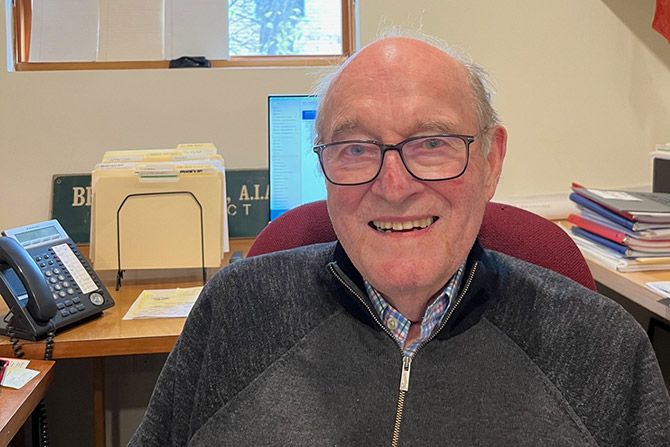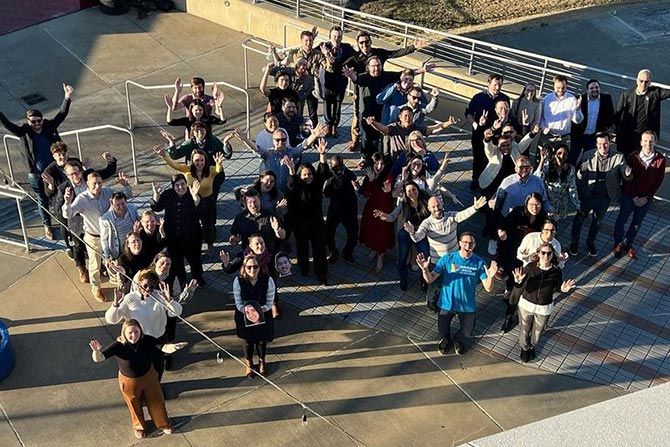Bruce started his own office, Bruce Hawtin Architect, in 1971 in Jackson, Wyoming, following work experience that took him overseas to Denmark and northern Virginia. He completed 12 years as a member of the State Board of Architects and Landscape Architects, serving as president for five years. He is a past president of AIA WY and was made a Fellow of the American Institute of Architects in 1998. He has won four recent AIA Merit Awards. Bruce has served on several nonprofit boards, including being elected to four terms as a St. John’s Health trustee. He has served on the board of directors for Jackson Hole Conservation Alliance and the Latino Resource Center (One 22), Center for the Arts, and Habitat for Humanity & Senior Center of Jackson Hole. He holds a Bachelor of Architecture from the University of Oklahoma. In 1997, Arne Jorgensen, a longtime employee, became a partner, and they became Hawtin Jorgensen Architects.
After nearly five decades in Jackson Hole, Bruce feels a greater sense of connection to the valley. This sense of belonging translates to his relationship with clients. He takes tremendous pride in the projects his firm has completed, feeling that each has made a positive contribution to the fabric of the Jackson Hole community.
At the age of 88, Bruce has not slowed down. On any given day, you can find him in his office, working with clients and designing projects to their specifications. We recently had a chance to sit down with Bruce and learn more about his career, his body of work and his thoughts on the industry. It was a pleasure speaking with Bruce, and we thank him for his time. The following are excerpts from our conversation.
When and why did you decide to become an architect?
During the 1950s, I was attending college and was not sure what I wanted to do. I was floundering. At the same time, every male had a military obligation, so I dropped out of college and volunteered for the draft. The Army sent me to post-war Korea. That two-year experience turned my life around. I found focus and decided that I wanted to be an architect.
Upon leaving the Army, I moved to Oklahoma. I remember entering the University of Oklahoma’s registrar’s office to apply for school. The lady there said, “Mr. Hawtin, we’re not letting you into the school due to your past academic credentials. We’re letting you in because you’re a veteran.” I replied, “Whatever it takes.”
Attending the University of Oklahoma was a very good decision. It’s an excellent school. After five years, I graduated with a degree in architecture. I spent a year practicing architecture in Denmark before returning to the U.S. A former acquaintance from college, who had been offering me a job for a while, reached out to me again and said, “This is the last time I’m offering you a job.” Thirty days later, I was in Jackson Hole. I loved everything about living and working in Jackson Hole, and in 1971, I opened my firm. At the time, there were only two other architects in town; now, there are over 30.
When I opened my office, I had one client, and 30 days after I opened, that client decided not to go forward with the project. So, I had a brand-new firm and no work. But I came up with another job fairly soon after; the rest is history.
What is your favorite architectural style?
If I had to put a name to the style, it would be Western rugged architecture. There’s a texture to the work I try to maintain. I work on contemporary buildings, but they have a texture to them. If there is one thing that we adhere to, it’s energy efficiency. That is a criterion of our work, and we’re known for that. Our buildings are very energy efficient. Building this way will pay for itself in energy savings in a reasonable period of time. And it’s worth doing.
Which projects have been your favorites?
My favorite type of project would be residential because you get so much satisfaction from designing a home for a couple or a family, especially when they get something they didn’t expect and love it. In total, I’ve designed over 200 houses.
I designed a house for my wife, Carolyn — who passed away five years ago — it was the most energy-efficient house in Jackson Hole at the time. And I think it probably still is. It was built on an arc and has south- and north-facing windows that let the sun in and allow for beautiful views. There are big overhangs, protecting it so it doesn’t overheat in the summer as it is not air-conditioned. The design regulates the temperature inside quite well.
A former client I designed a house for 30 years ago called me about a year ago and asked, “Bruce, are you still practicing?” I said, “Hell yes!” This client is a rancher who owns a property north of town. It’s probably the biggest privately held piece of property in the county. He let me know that he and his wife had thoroughly enjoyed their home and that they had some more work for me on other buildings on the ranch. He wanted a new shop, an employee housing unit, and to remodel another building. I was thrilled that he called me after all those years.
About 20 years ago, I was preparing for a client interview on a Monday. It was the Saturday before, and I decided to go to the property to become familiar with it. As I was walking the property, a car pulled up. The guy exited his vehicle and said, “This is my property. What are you doing on it?” I replied, “I’m Bruce. You’re going to interview me on Monday to be your architect. I wanted to be familiar with your property before the interview.” He said on the spot, “You’re hired.” He was impressed that an architect would take the time to look up the property and become familiar with it before any work started. I ended up building a home for him and his family there, and it’s one of my favorites.
In 1985, I designed the City Hall in Jackson Hole. I’ve always loved that building, and it functions beautifully. It has a clock tower you enter under to get into the building. The council chambers have a semicircular desk, so when the mayor and the council are sitting, they can see each other because it’s an arc. This was rather controversial when it was built, but ultimately, everybody loved it.
I also designed a big building downtown across the street from the Wort Hotel. It was a big commercial building with an escalator — the only escalator ever in Jackson Hole. But the maintenance of that escalator was so overwhelming that they took it out. But it was fun while it was there.
What career accomplishment are you proudest of?
I’m a member of the College of Fellows, which is quite an honor. It’s a very lengthy process to apply. I was the first to become a Fellow in Wyoming; there are three of us now and a couple of others who are currently applying.
There are a lot of different categories that you can apply to be a Fellow. My category was making the profession of architecture more available to the general public. I have started several nonprofits in Jackson Hole and am a member of several others. I was on the hospital board for four terms — an elected position. I am blessed to bring the profession to these nonprofit boards and get a certain amount of PR as a result.
What advice would you give to a young architect?
I encourage young architects to learn how to make their buildings energy-efficient. There are dozens of ways to do that, some of which are not very complicated. Next would be to design buildings that fit their environment. Don’t design a building for Jackson Hole that looks like it belongs in Newport or Los Angeles. Finally, be open, honest and straightforward. People appreciate that.










